When traveling in Southeast Asia, be sure to try halal dishes like Nasi Lemak for fragrant coconut rice, Hainanese Chicken Rice with tender poultry, and spicy Laksa noodle soup. Don’t miss satay skewers grilled to perfection, crispy Ayam Goreng, or rich Beef Rendang. These flavorful options reflect the region’s diverse culinary heritage and halal standards. Keep exploring to discover more delicious dishes and local food secrets that will make your trip unforgettable.
Key Takeaways
- Explore iconic halal rice dishes like Nasi Lemak and Hainanese Chicken Rice for authentic Southeast Asian flavors.
- Try flavorful grilled and fried meats such as Satay Skewers and Ayam Goreng, popular street foods across the region.
- Savor spicy soups and curries like Laksa and Roti Canai with Dhal for a taste of local culinary diversity.
- Enjoy rich stews like Beef Rendang that highlight aromatic spices and cultural authenticity.
- Ensure halal options are available when experiencing these diverse dishes to enjoy safe and authentic Southeast Asian cuisine.
Nasi Lemak: Malaysia’s Aromatic Coconut Rice Dish

Nasi Lemak is Malaysia’s beloved aromatic coconut rice dish that’s often considered the country’s national comfort food. When you smell it, the coconut aroma immediately transports you, filling the air with a warm, inviting scent. The rice’s texture is perfectly fluffy yet slightly sticky, making it ideal for scooping with your hands or chopsticks. The coconut infusion gives each grain a rich, fragrant flavor that’s both soothing and satisfying. As you take a bite, you’ll notice how the rice remains moist and tender, balancing well with the accompanying savory, spicy, and crunchy elements. To enhance your experience, consider the optimal rice texture that makes Nasi Lemak uniquely enjoyable. The use of self-watering plant pots in Malaysia’s lush gardens reflects the country’s appreciation for efficient and sustainable gardening methods, mirroring the harmony found in traditional dishes. Nasi Lemak isn’t just a meal; it’s an experience of Malaysia’s culinary soul, offering a harmonious blend of aroma and texture that keeps locals and travelers coming back for more.
Satay Skewers: Grilled Meat Delights Across the Region
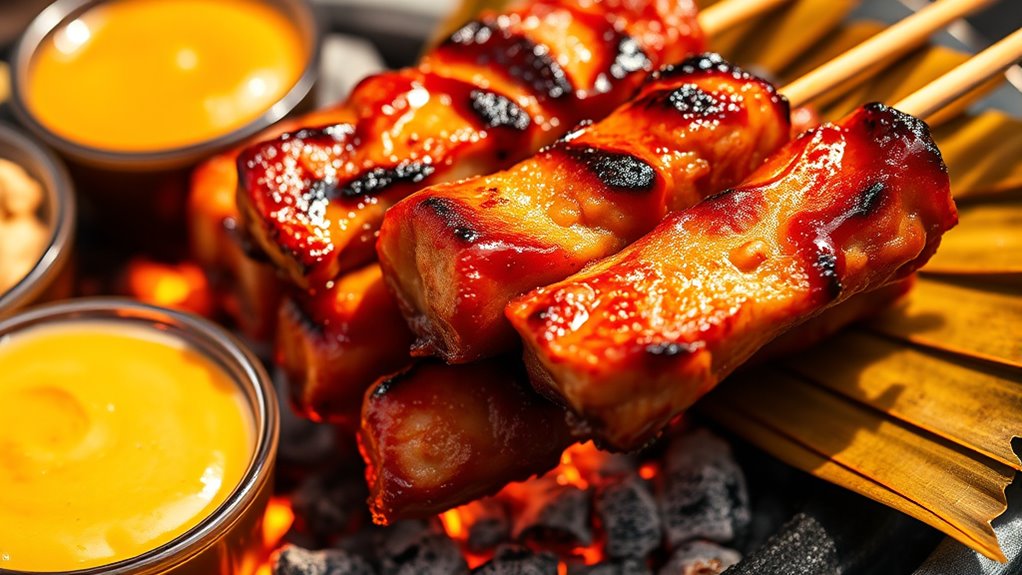
Across Southeast Asia, the smoky aroma of grilled meats often signals the arrival of satay skewers—an iconic street food beloved in countries like Indonesia, Malaysia, and Thailand. You’ll find vendors expertly grilling skewered meats over open flames, filling the air with irresistible scents. The key is the tender, flavorful grilled satay, often made with chicken, beef, or lamb, marinated in spices and threaded onto bamboo skewers. As you bite into these skewered meats, you experience the perfect balance of smoky char and savory marination. Served with a rich peanut sauce or spicy sambal, satay skewers are a must-try for any traveler seeking authentic, halal-friendly street food across the region. They’re a delicious, portable delight you won’t forget. Heat pumps are an example of innovative technology that enhances comfort and energy efficiency, which can be a useful consideration for travelers seeking sustainable options in accommodations. Exploring local markets can also deepen your appreciation for regional culinary traditions and the cultural significance of street food.
Laksa: Spicy Coconut Noodle Soup From Singapore and Malaysia
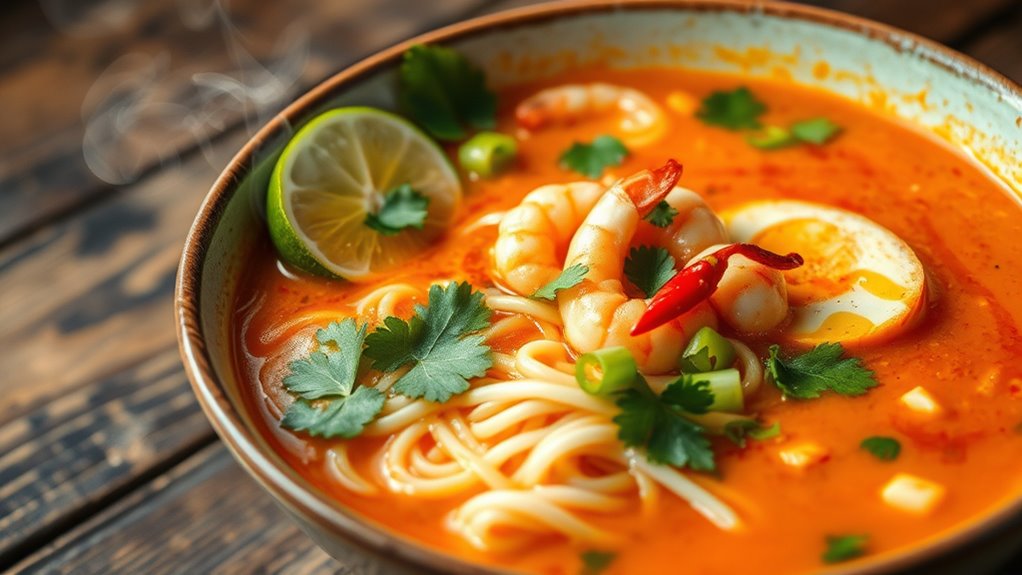
Laksa is a popular spicy coconut noodle soup enjoyed in Singapore and Malaysia, with each region offering its own twist. You’ll find authentic variations that highlight local ingredients and flavors, making it a unique experience in every bowl. Halal standards guarantee these dishes meet strict preparation methods, so everyone can savor this flavorful comfort food. Building your dream backyard greenhouse can also help you grow fresh herbs and ingredients to customize your own laksa at home. Regular use of glycolic acid in skincare routines can improve skin texture and radiance, complementing your culinary adventures with a healthy glow.
Authentic Regional Variations
While laksa is beloved throughout Southeast Asia, its regional variations highlight distinct flavors and techniques that reflect local tastes. In Singapore, laksa features a rich, spicy coconut broth infused with regional spices like lemongrass, galangal, and turmeric, prepared using simmering and blending techniques that deepen the flavor. Malaysian laksa, especially Penang’s version, often emphasizes a tangy, herbal profile, incorporating ingredients like tamarind and fresh herbs, with cooking techniques that involve frying spice pastes for a more intense aroma. Both variations utilize rice noodles and fresh toppings, but their unique spice blends and preparation methods create diverse flavor profiles. Exploring these authentic regional differences allows you to experience how local ingredients and cooking styles shape each version of this iconic dish.
Halal Preparation Standards
When preparing laksa in Southeast Asia, ensuring that the dish adheres to halal standards is a top priority for many cooks and diners. Halal certification is essential, confirming that ingredients, especially seafood, chicken, and spices, meet Islamic dietary laws. Maintaining strict hygiene standards is equally important to prevent cross-contamination with non-halal products. Proper kitchen practices, such as using separate utensils and storage areas, help guarantee the integrity of the dish. Vendors and chefs must stay vigilant about cleanliness and certification authenticity to earn customer trust. Regular inspections and adherence to food safety guidelines further ensure compliance and quality. Additionally, understanding how color accuracy and other technical standards impact food presentation can elevate the overall dining experience. Proper training in halal compliance ensures that food preparation aligns with religious requirements and maintains consumer confidence. Emphasizing kitchen sanitation and proper handling techniques is crucial for upholding halal standards. By adhering to these standards, you guarantee that your laksa remains halal, allowing Muslim travelers to enjoy this spicy coconut noodle soup confidently and comfortably.
Roti Canai With Dhal: Flaky Flatbread Paired With Lentil Curry
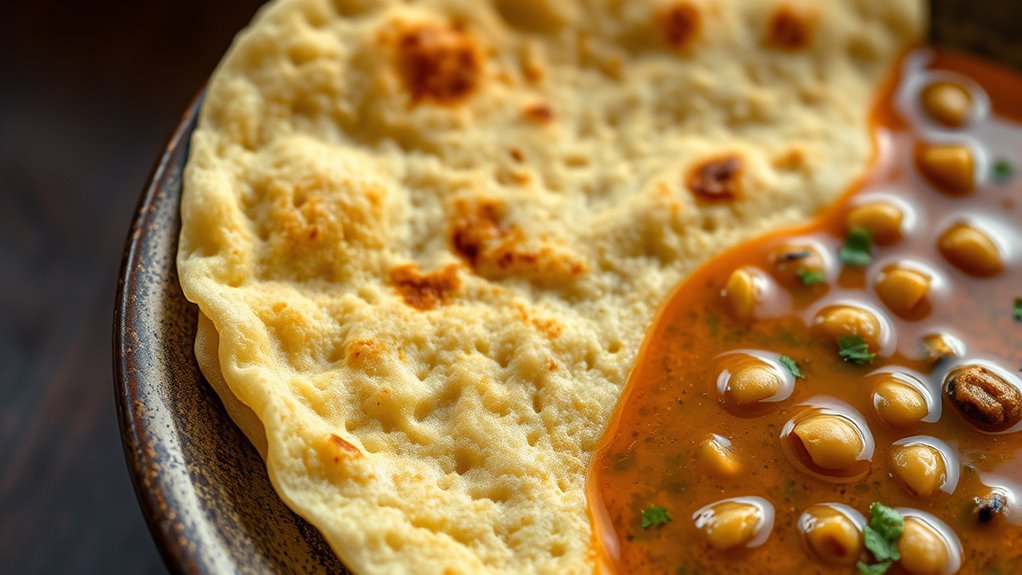
Have you ever tasted the perfect combination of crispy, flaky flatbread and hearty lentil curry? Roti canai with dhal offers just that, showcasing a dish with deep roots in Southeast Asia’s culinary scene. The traditional preparation involves stretching and flipping the dough until it’s thin and layered, then frying it to golden perfection. This method highlights its cultural significance, originating from Indian influence but now a staple in Malaysian, Singaporean, and Indonesian breakfasts. When paired with spicy lentil curry, the textures and flavors complement each other beautifully. The flaky exterior contrasts with the smooth, flavorful dhal, making it a satisfying and authentic experience. This dish isn’t just food; it’s a reflection of Southeast Asia’s diverse cultural tapestry. Halal culinary traditions play a key role in preserving and showcasing these vibrant flavors across the region.
Beef Rendang: Rich and Spicy Indonesian Coconut Beef Stew
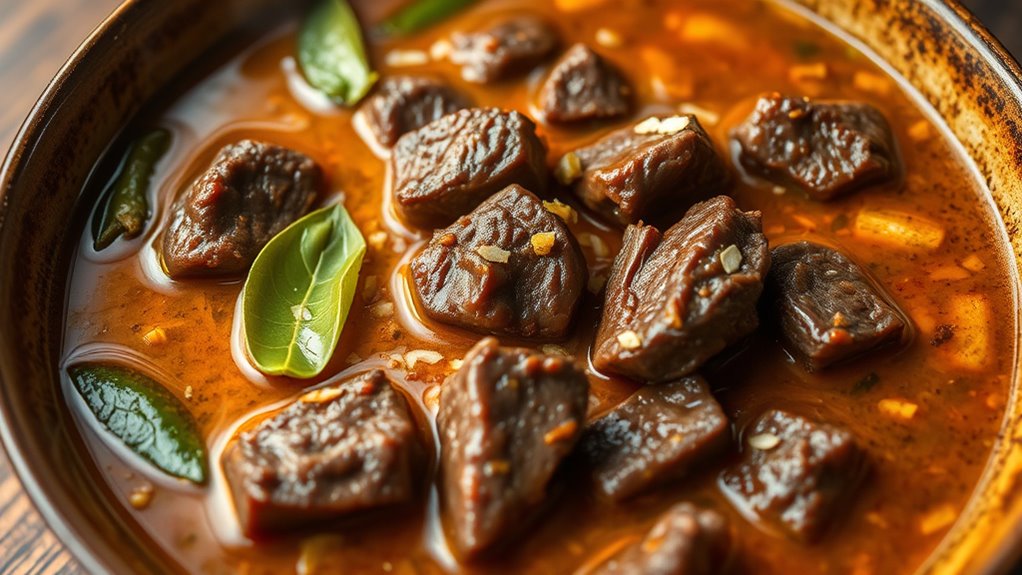
Beef Rendang is a flavorful Indonesian dish known for its tender meat simmered in a rich, spicy coconut sauce. As you savor this coconut stew, you’ll notice the aroma of toasted spices blending with coconut milk, creating a mouthwatering experience. The beef absorbs the spices, becoming melt-in-your-mouth tender. Imagine the vivid colors and textures:
| Ingredients | Sensations |
|---|---|
| Spicy chili paste | Warmth in every bite |
| Coconut milk | Creamy richness |
| Lemongrass | Fragrant aroma |
| Beef chunks | Juicy, tender texture |
This dish’s deep flavors and aromatic profile make it a must-try when exploring Southeast Asian halal cuisine.
Hainanese Chicken Rice: Juicy Chicken With Fragrant Rice From Singapore and Malaysia
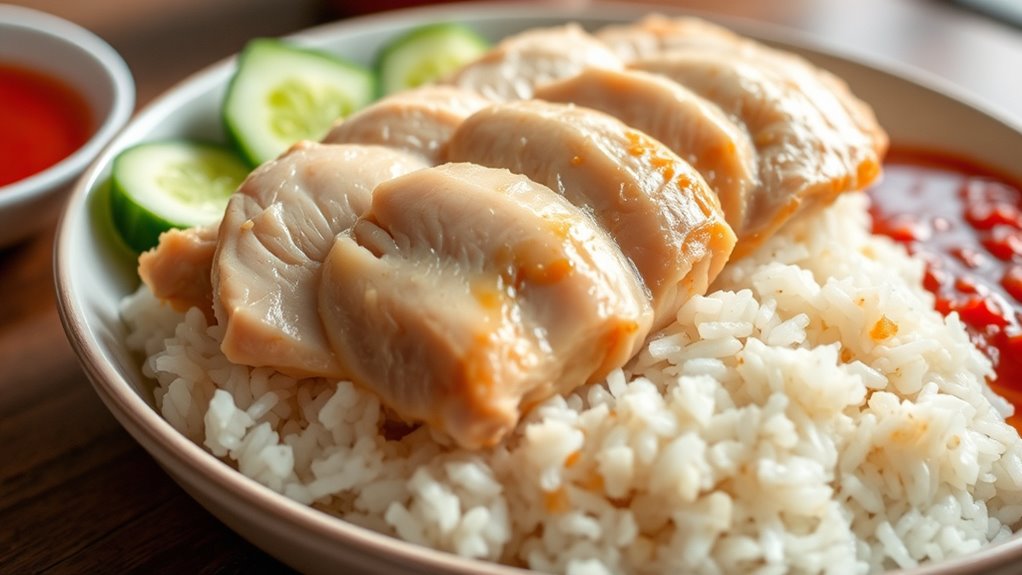
- Poaching the chicken carefully to retain moisture and achieve a silky texture.
- Using chicken stock and pandan leaves to infuse the rice with aroma.
- Incorporating garlic and ginger in the cooking process for added flavor.
- Varying the chicken cuts, like breast or thigh, based on preference.
These methods highlight how subtle changes in *cooking techniques* and *ingredient variations* can elevate the dish. Whether you prefer a simple or more complex flavor profile, Hainanese Chicken Rice remains a must-try in Southeast Asia.
Ayam Goreng: Crispy Fried Chicken Popular in Indonesia and Malaysia
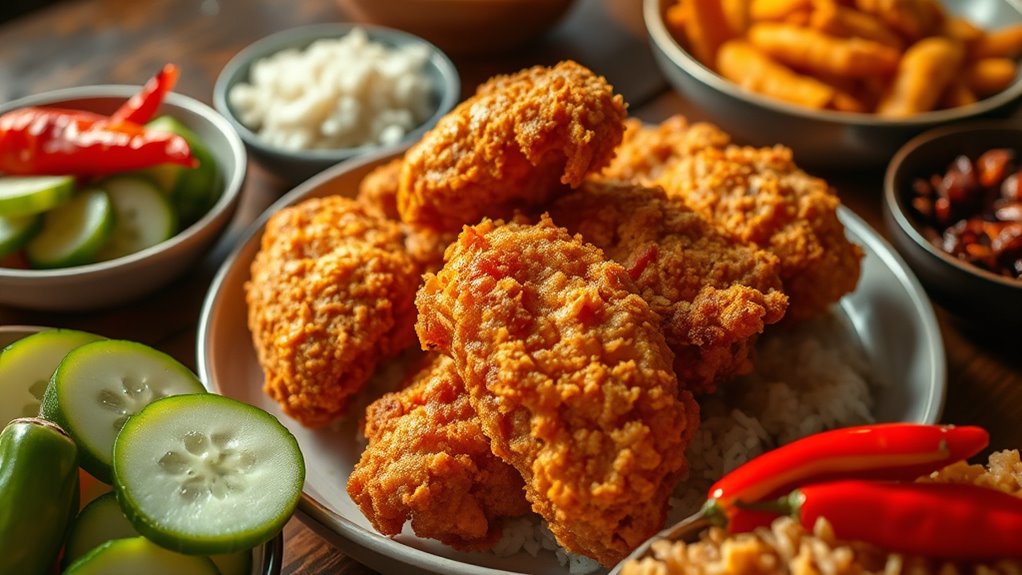
Ayam Goreng, the beloved crispy fried chicken, holds a special place in Indonesian and Malaysian cuisine. You’ll notice the cooking techniques involve marinating the chicken with spices and herbs, then deep-frying it to achieve a golden, crunchy exterior. The spice levels can vary based on local preferences, from mildly seasoned to boldly spicy. As you bite into Ayam Goreng, you’ll enjoy the tender meat inside contrasted with the crispy skin. Some versions incorporate turmeric, garlic, and coriander, enhancing flavor and aroma. The dish is often served with rice, sambal, or fresh vegetables, making it a satisfying halal meal. Its irresistible crunch and flavorful seasoning make Ayam Goreng a must-try dish during your Southeast Asia travels.
Frequently Asked Questions
Are These Dishes Suitable for Vegetarians?
You might wonder if these dishes suit vegetarians. Many Southeast Asian halal dishes can be adapted for vegetarians by asking for ingredient substitutions, like replacing meat with tofu or vegetables. However, not all dishes are naturally vegetarian, so it’s best to verify with the restaurant. Always communicate your dietary needs clearly to ensure the dish contains no meat or animal-derived ingredients you avoid.
How Spicy Are These Traditional Southeast Asian Dishes?
You might worry about the spice levels in Southeast Asian dishes, but they vary widely depending on ingredient variations and preparation. Many dishes can be mild or fiery, so you can often request less spice if you’re sensitive. Traditional recipes tend to balance flavors well, ensuring you enjoy the authentic experience without overwhelming heat. Always ask about spice levels beforehand to find the perfect dish suited to your palate.
Can I Find Halal-Certified Versions of These Dishes Easily?
You’ll find halal-certified versions of many Southeast Asian dishes easily, thanks to growing awareness of food safety standards. When dining, look for restaurants displaying halal certification, which guarantees the food meets strict safety and ingredient guidelines. In popular tourist spots, halal options are widely available, making it convenient for you to enjoy local flavors confidently and safely without worrying about food safety standards or dietary restrictions.
What Are the Typical Side Dishes Served With These Mains?
You’ll find that typical side dishes serve as perfect accompaniment options to enhance your main course. In Southeast Asia, traditional flavor pairings often include fragrant rice, fresh vegetables, and tangy sambal or chili sauces. These accompaniments balance the spices and add layers of flavor, making your meal more satisfying. Expect to enjoy dishes like pickled vegetables, prawn crackers, or light salads that complement the rich, flavorful mains seamlessly.
Are These Dishes Available at Street Food Stalls or Only in Restaurants?
You’ll find these dishes both at street food stalls and in restaurants, offering you a taste of local flavor wherever you go. Street food stalls often provide street food authenticity—vibrant, quick, and budget-friendly—while restaurants give you a more refined ambiance. Whether you seek the lively buzz or a cozy setting, both options serve delicious halal dishes, ensuring you enjoy the rich culinary culture of Southeast Asia comfortably and conveniently.
Conclusion
Begin a flavorful journey through Southeast Asia, where these halal dishes are treasures waiting to be discovered. Each bite is like unlocking a secret chest of spices, aromas swirling like vibrant tapestries, and textures that dance on your palate like a lively festival. These dishes aren’t just food—they’re a passport to the heart of the region’s rich culinary tapestry, inviting you to savor every moment and create unforgettable memories with every flavorful bite.









